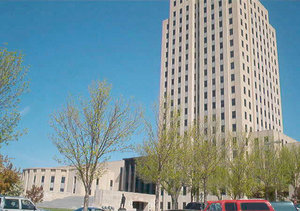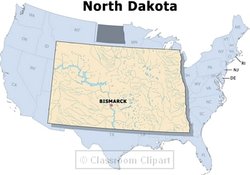Bismarck, North Dakota
|
|
Bismarck is the capital of North Dakota, a state of the United States of America. It is named for the German chancellor Otto von Bismarck. As of the 2000 census, it has a population of 55,532. It is the county seat of Burleigh County, and sits directly across the Missouri River from Mandan, North Dakota.
The local newspaper is the Bismarck Tribune. Bismarck Municipal Airport serves the city.
| Contents |
Geography
Template:US City infobox Bismarck is located at 46°48'48" North, 100°46'44" West (46.813343, -100.779004)Template:GR.
According to the United States Census Bureau, the city has a total area of 71.0 km² (27.4 mi²). 69.6 km² (26.9 mi²) of it is land and 1.3 km² (0.5 mi²) of it is water. The total area is 1.90% water.
Demographics
As of the censusTemplate:GR of 2000, there are 55,532 people, 23,185 households, and 14,444 families residing in the city. The population density is 797.4/km² (2,065.2/mi²). There are 24,217 housing units at an average density of 347.7/km² (900.6/mi²). The racial makeup of the city is 94.78% White, 0.28% Black or African American, 3.39% Native American, 0.45% Asian, 0.03% Pacific Islander, 0.17% from other races, and 0.89% from two or more races. 0.75% of the population are Hispanic or Latino of any race.
The top 6 ancestries in the city are: German (57.9%), Norwegian (18.2%), Russian (7.7%), Irish (7.2%), English (5.0%), Swedish (4.3%).
There are 23,185 households out of which 30.2% have children under the age of 18 living with them, 50.1% are married couples living together, 9.3% have a female householder with no husband present, and 37.7% are non-families. 31.0% of all households are made up of individuals and 10.5% have someone living alone who is 65 years of age or older. The average household size is 2.32 and the average family size is 2.94.
In the city the population is spread out with 23.5% under the age of 18, 11.1% from 18 to 24, 29.1% from 25 to 44, 22.4% from 45 to 64, and 13.8% who are 65 years of age or older. The median age is 36 years. For every 100 females there are 93.9 males. For every 100 females age 18 and over, there are 91.8 males.
The median income for a household in the city is $39,422, and the median income for a family is $51,477. Males have a median income of $33,804 versus $22,647 for females. The per capita income for the city is $20,789. 8.4% of the population and 5.7% of families are below the poverty line. Out of the total population, 9.5% of those under the age of 18 and 7.4% of those 65 and older are living below the poverty line.
Education
- K-12
The Bismarck public school system has 15 elementary schools, 3 middle schools, and 2 high schools. There are also a number of private schools in the city.
- Higher Education
The University of Mary is the largest degree-granting institution in the city. Bismarck State College is a member of the North Dakota University System. Bismarck is also home to United Tribes Technical College and a satellite campus of Aakers College.
External links
Template:Geolinks-US-cityscale
| Regions of North Dakota | 
|
|---|---|
| Red River Valley | Missouri Escarpment | Badlands | |
| Largest cities | |
| Beulah-Hazen | Bismarck-Mandan | Devils Lake | Dickinson | Fargo-West Fargo | Grafton | Grand Forks | Jamestown | Minot | Rugby | Valley City | Wahpeton | Williston | |
| Counties | |
|
Adams - Barnes - Benson - Billings - Bottineau - Bowman - Burke - Burleigh - Cass - Cavalier - Dickey - Divide - Dunn - Eddy - Emmons - Foster - Golden Valley - Grand Forks - Grant - Griggs - Hettinger - Kidder - La Moure - Logan - McHenry - McIntosh - McKenzie - McLean - Mercer - Morton - Mountrail - Nelson - Oliver - Pembina - Pierce - Ramsey - Ransom - Renville - Richland - Rolette - Sargent - Sheridan - Sioux - Slope - Stark - Steele - Stutsman - Towner - Traill - Walsh - Ward - Wells - Williams |


